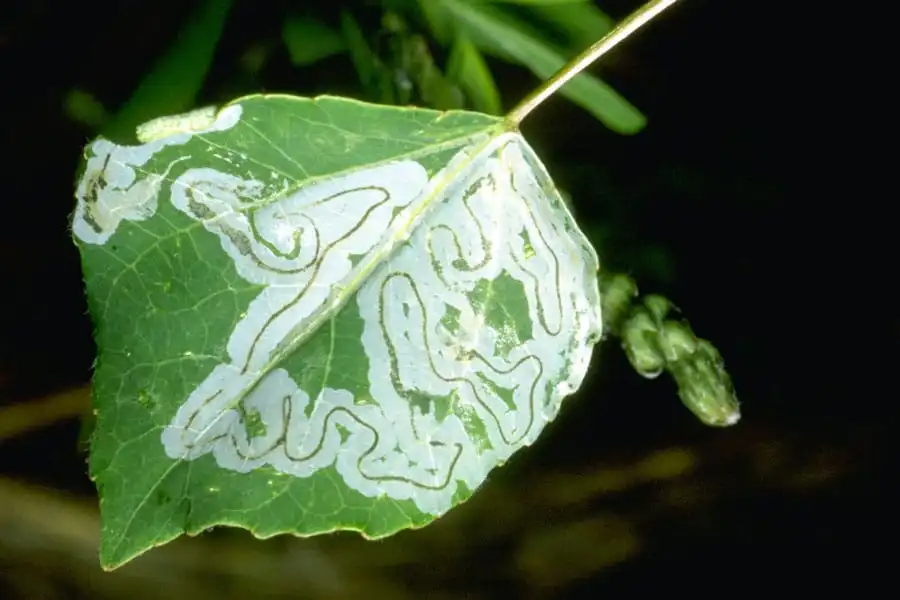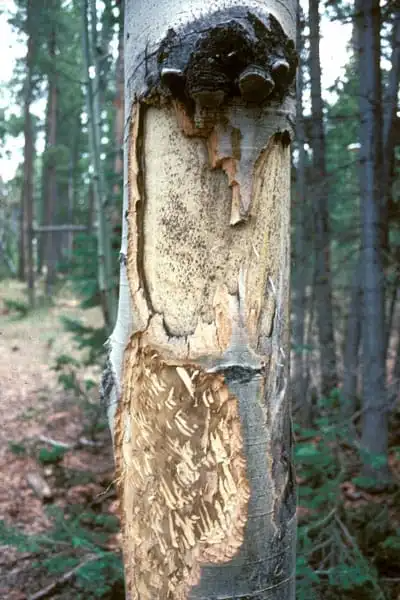Aspen Trees: Common Problems and What To Do
Aspens are the prevailing tree in our part of the Colorado Front Range and a favorite with many residents in Evergreen and the surrounding areas. Unfortunately, aspen trees are also susceptible to a wide range of problems. For example, they’re prone to many types of injuries (like deer or elk rubbing and browsing), diseases (like aspen leaf blight) and pests (such as spider mites).
About Aspen Trees
The aspen (Populus tremuloides) is an iconic keystone tree species, and its mixed understory supports a diverse ecosystem throughout the higher elevations of the Rocky Mountains.
Aspen trees naturally grow in groves, rather than as individual trees. An aspen grove will have trees at all stages of life, from sprouting shoots to mature specimens, all connected underground by a large system of interconnected roots. In fact, the largest known living organism in the world is the Pando aspen grove in the Fishlake National Forest, UT!
In an ideal setting, aspens remain healthy and resist damage while spreading roots and sprouting new trees from them. But in residential or commercial settings (such as the landscape surrounding your home or business), problems can severely affect aspen health and appearance.
For example, the aspen is commonly affected by:
- insect pests
- fungal infections
- animal browsing and injury
- drought and heat
- fire suppression and conifer growth
However, the biggest problem aspens face in an ornamental landscape is the soil it’s planted in.
The Importance of Soil Quality for Aspen Health
Many aspens are planted in the landscape surrounding a home (often within 10′-15′ of the foundation). The problem is that there’s no good soil in that area. When we build our homes, we excavate to put the foundation in. The area around it is then backfilled with the mix of material that was dug out of the hole to put in the foundation. This mixture isn’t topsoil and it’s certainly not what aspens need (it’s nothing like what’s found in the drainage areas of mountain climates where aspen thrive).
But that’s just the beginning. Aspens need to clone themselves to stay healthy (that’s why they naturally grow in groves). They do this by sending out tons of “suckers,” many of which end up in spots where homeowners don’t want them. So, we cut them out or let the elk/deer eat them to the ground. Either way, the aspen can’t grow to put out more leaves that would help them combat stressors, such as insects and disease.
As a result, aspens have the most problems of all our local plants. In fact, they seem to be perpetually afflicted by a new problem, no matter how many or how often treatments are applied. And it all starts with how and where they’ve been planted. When something starts out in a bad way, rarely will it improve.
Can I improve the soil / environment for my aspens?
Assuming your aspen’s already been planted, there are two things you can do to improve its chance of success.
First, have a tree care professional apply a soil injection that includes a blend of fertilizers and nutrients to improve soil health, as well as a systemic product to get rid of insects and mites.
Second, protect the young shoots so the aspen can help itself. Sometimes it’s as simple as not cutting them out but you can also put up a physical barrier to prevent deer or elk browsing.

Aspen leafminer damage.
Insect Pests
Several insects damage aspens, mostly by leaf rolling and eating the foliage (such as the aspen leafminer shown above, or various types of caterpillar). In addition, we often see aphids in aspens; they secrete a sticky substance called honeydew that results in an unsightly, black sooty mold covering the leaves and everything beneath the tree.
We also see a lot of spider mites on aspen trees, particularly in drier locations. The damage they cause is sometimes confused with fungal leaf diseases.
Other common insect pests that attack aspen will damage the trunk. These include poplar borers and oystershell scale.
Oystershell scale appears as tiny black dots and with a hand lens will look like an oyster shell. Poplar borer is a beetle that makes holes in the bark; you’ll also see pieces of wood around the hole and below it on the ground. Sometimes these holes leak a brown resin (the aspen sap) that runs in streaks down the trunk.
Treatment for Insect Pests
If you plan on spraying an insecticide, such as Bt (Bacillus thuringiensis), follow all directions to ensure you are spraying at the right time to reduce insect populations. Early in the growing season you can also wrap a wide strip of flexible paper around the trunk and coat it with a sticky barrier to trap insect larvae that crawl up into foliage.
You may find that spraying entire large trees is unfeasible, or that you require a tree care professional to spray (which is what we recommend for larger trees – it’s very difficult to adequately cover the entire tree without specialized spray equipment). If you don’t want to spray trees, remember that during their growing season, aspens regenerate leaves quickly, so if you can, endure some leaf damage knowing it will be replaced with new leaves.
A Certified Arborist can also apply insecticide sprays at the end of the season (when a systemic treatment wouldn’t be effective) and/or when the population of a specific pest needs to be quickly reduced to avoid extensive aspen damage.

Aspen ink spot leaf blight
Fungal Problems
Aspens are affected by a variety of fungal problems that affect the foliage, including leaf spot, aspen leaf blight, and rust. Most of these diseases can defoliate the tree. Although it requires repeated, severe incidents of leaf blight and dieback to kill a tree, annual leaf blight makes aspens look unhealthy, and reduces the desirable characteristics of delicate branches and green, fluttering leaves.
Another common aspen tree problem is cytospora canker. This fungal disease causes patches of bright orange bark that (usually, but not always) ooze brown liquid. After a few years, the bark begins to fall off and you’ll see dark brown or black areas beneath it.
What can you do about fungal problems?
- Irrigate only in early morning, and do not wet foliage with irrigation
- Maintain moist, but not wet, soil – water regularly during dry spells, including in winter
- Clean up and discard diseased leaves, twigs and branches that have been affected by any kind of fungal problems, especially in fall.
- Prune out diseased twigs and branches, and repair damaged or broken areas ASAP
- Plant trees with enough space between them to allow for air and sun to reach them
- Avoid trunk damage from mowers and string trimmers
- Fertilize to ensure adequate nutrient levels, but don’t over-fertilize
- Spray with fungicide
Treatment for Fungal Problems
If you choose to spray your aspens with fungicides, do it early in the season (at bud break when leaves are about the size of a dime, which is usually in late May to early June). We recommend a second application about 12 to 14 days later. Usually, two (or sometimes three) applications per season will control fungal leaf diseases on aspen.
These sprays will keep new infections from establishing. Sprays cannot repair existing damage or “cure” a fungal disease, so removing damaged twigs and leaves is an important part of keeping down the level of fungal spores that can spread the infection.
If you’re unsure what or when to spray, check with the local experts at LAM Tree Service to make sure you use the best fungicide for your specific leaf disease.

Elk damage to an aspen tree
Animal Damage
Animals can seriously damage aspen trees, primarily by eating the shoots of young suckering trees that sprout from the aspen’s root system, as well as by eating bark. In an undisturbed or balanced forest, trees regulate new growth and maintain trunk spacing and sunlight levels. But when animals over-browse aspen stands, they reduce understory species, damage tree bark, and leave open areas within the stand. Evergreen species such as conifers take advantage of these openings to quickly grow, shading out the surrounding aspens and causing them to decline.
We also see problems with deer and elk rubbing their antlers against the bark, causing large wounds and even killing the tree altogether. Damage is particularly prevalent during the elk rut which usually begins in the fall (roughly mid-September through mid-October) although it sometimes lasts through November.
How can you prevent animal damage to aspens?
In residential properties, a strong barrier fence is the best defense against browsing deer and elk. Aspens can also be wrapped with a tough plastic that lessens the amount of antler damage (although a large bull elk can knock down a smaller aspen, regardless of whether or not it’s wrapped). Wraps should be removed in spring.
Heat & Dry Conditions
Aspens like cold winters, warm summers, and moist soil, which is why you typically find them in the higher elevations of the Front Range. Lower, valley conditions are usually hotter and drier, stressing the trees and making them more susceptible to fungi and insect damage.
We see so many aspens planted in a dry, south-facing landscape where they’re exposed to conditions that are well outside their natural environment. It’s no wonder they don’t do well!
What to do in hot, dry conditions
Be sure to monitor your soil’s moisture level to ensure your aspens have enough water. You may also need to water aspens in winter (when there’s no snow on the ground) to keep them hydrated. Also spread mulch on the soil around trees to retain soil moisture; just be sure to keep mulch away from trees’ trunks.
If you store cut firewood, keep the wood away from the aspens and cover the pile with a waterproof tarp. Bury the edges of the tarp in soil to prevent any insect larvae from crawling out and reaching the aspens.
Fire
Aspens respond to forest fires by sprouting suckers in the new, open burn areas. If a fire has burned a stand of trees, sprouts from their underground root system appear soon after to refill the stands. Fire also removes any conifer species that have sprung up into the stand and threaten to shade out the aspens.
So while fire mitigation is an important part of living in this beautiful part of Colorado, wildfires are not necessarily a bad thing for aspens.
Alternatives to Plant Instead of Aspen Trees
If your property doesn’t have conditions that are best for aspens, but you want to approximate the feel of them, consider alternatives such as:
- American mountain-ash (Sorbus americana) flowers in spring and produces bunches of red berries. Deciduous leaves have bright fall color.
- The Oakleaf Mountain ash (Sorbus x hybrida) flowers and produces berries, but has leaves reminiscent of an oak tree.
- Ash trees (Fraxinus sp.) have similar pinnate leaves to the sorbus, and smooth gray bark and fall color.
- River birch (Betula occidentalis) has smooth reddish bark and leaves similarly shaped to aspens, that turn gold in fall.
- Mountain Alder (Alnus tenuifolia) likes moist soil, has green leaves with a white underside, and smooth gray bark.
- Serviceberry (Amelanchier x grandiflora) has a similar look to an aspen and fits well in tight spots in the ornamental landscape.
Instead of aspens, plant these 7 tree alternatives for fall in Colorado.
Check with your local nursery to find out if these alternatives are suitable for your garden, and what their maintenance needs will be.
The Bottom Line
Aspens are beautiful trees that give the Rockies part of their character and appeal. However, in the Evergreen area and at lower elevations they’re prone to a range of problems that affect their appearance and health.
Maintaining the health of aspens in our area will likely require professional assistance from a Certified Arborist. If you’re concerned about your trees, please give us a call at 303-674-8733 or request an inspection.
~Lam Tree Service
Selling Your Home?
Get your home's value - our custom reports include accurate and up to date information.




